Dolphin 文件管理
发掘 Dolphin
第一部分将带您预览 Dolphin。第二部分涉及不同类型的书签的概念。第三部分讨论文件管理。最后,我们来看'更酷的东西'。可以点击图片查看大图。
常规信息
Dolphin 或是 Konqueror?
这份指南描述的是 KDE SC 4 的 Dolphin。Konqueror 是 KDE 2 和 KDE 3 的标准文件管理器。你依然可以在 KDE SC 4 中使用 Konqueror 当默认文件管理器。在 KDE SC 4.2 之后, 打开系统设置,然后找到,选择 Konqueror 或其他程序当默认文件管理器。
- D3lphin 是 KDE 3 上的 Dolphin 分支。它缺乏 KDE SC 4 Dolphin 的一些特性。而且由于 KDE 3 默认文件管理器是 Konqueror 的缘故而鲜为人知。社区不支持该分支,原作者也不再维护。
介绍 Dolphin
Dolphin 是 KDE 软件集(Software Compilation)的文件管理器。
我会展示如何用 Dolphin' 完成一般的文件管理任务和定制它满足你的需要。
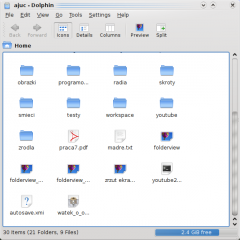
当我们从Kickoff菜单里打开 Dolphin,他首先显示的是开始目录- 通常是 主文件夹。
在文件夹里点击即可打开文件(如果你喜欢双击打开,KDE 4.5 中在改)。
要选择和取消选择文件/文件夹,悬停鼠标指针到图标上,点击出现的+号来选择,点-号来取消选择。像是这样:
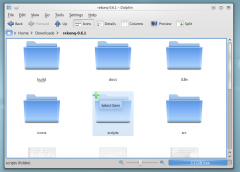
当你点击+号,文件/文件夹就会被选中。你可以用这种方法选定多个文件(鼠标拖拽矩形选择文件也是有效的)。你也可以用Ctrl + 单击一次一个的选定/取消选定,Shift + 单击来连续操作。
多个被选中的文件看起来是这样的:

创建新文件夹:你可以在当前活动的目录下用菜单,或快捷键 F10。
标签:Dolphin 支持多标签浏览。举例来说或Ctrl + T或鼠标中键点击文件夹图标和导航按钮(前进/后退)。
点击如何文件夹的时候都会默认启动 Dolphin。也能在 Kickoff 菜单里启动它.
导航栏
Dolphin 整合了新概念以一种更快速和更准确的方法使用导航栏。因此使用了新的面包屑(breadcrumb)导航栏。取代传统的显示完整的路径,仅从「地址」之一开始的导航点作为按钮显示。点击那些按钮你能直接进入这个文件夹。所以你能快速的从一个子文件夹到达父文件夹。
在代表文件夹的按钮之间有一个小的箭头也是个可点击的按钮。点击这个箭头你能看到一份列表,列表里是跟你现在这个目录同级的所有子目录(译者注:这说的是你点当前这个文件夹按钮前的「箭头」的情况,其实列表显示的就是「箭头」前那个文件夹的所有子文件夹),使你能快速改变目录。
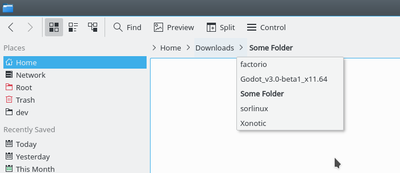
同样也有一个显示完整路径的经典导航栏。要使用这种样式,你需要选择或用键盘快捷键 Ctrl+L 触发。点击「面包屑样式」里紧跟最后一个显示文件夹的空旷区域,你也能改变到经典样式。一旦选择了「经典样式」,一个标记符号就会在导航栏末端出现。这个标记符号是个按钮,可以用来返回样式到「面包屑样式」。当然也能用菜单和键盘快捷键。
拆分视图
Dolphin 能够拆分当前文件夹视图产生出两个彼此相邻的文件夹视图,参考Midnight Commander。这种浏览方式非常适合从一个文件夹复制或移动文件到另一个文件夹。
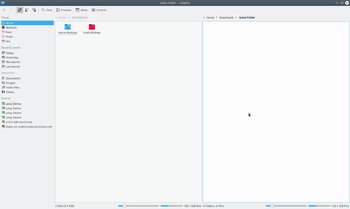
你能用 (键盘快捷键F3)拆分视图。要变回到只有一个文件夹视图,你可以点。小图标会显示哪个视图会被关闭。取决于当前激活的视图,减号会显示在图标的左侧或右侧。激活的视图会被关闭。如果你想用键盘快捷键操作的话,需要知道这点。在工具栏上也有一个用来拆分和关闭视图按钮。这个按钮也会显示减号,所以很容易的能看出来哪个视图会被关闭。
当然每个视图都有他自己的导航栏,每个视图也能用不同的视图模式。
视图模式
Dolphin 支持三种不同的视图模式:"图标", "细节" 和 "分列"。可以通过菜单变更或通过键盘快捷键Ctrl+1(图标), Ctrl+2 (细节) 和 Ctrl+3 (分列)。在工具栏上也有对应每个视图模式的按钮,文件夹浏览的相关右键菜单也提供子菜单来改变视图模式。
图标
在"图标"视图模式下每个文件和每个文件夹都用一个图标表示。也可以显示文件的缩略图取代显示图标。这种做法可以通过菜单或是通过工具栏按钮开启/关闭。文件预览是有大小限制。这个大小限制可以在选项自定义。这里也有选项在预览时使用嵌入到文件里的缩略图(比如说mp3文件里的专辑封面)。KDE 4.5中预览通过选项开启、配置。
默认在现在选择的文件夹内的文件是依字母顺序排序。通过菜单
- 名字
- 大小
- 日期
- 权限
- 拥有者
- 群组
- 类型
此外排序序列可以用<menuchoice>查看 -> 排序方式 -> 降序定义。
Dolphin 能够在图标下显示额外的信息。这些信息可以通过启用/关闭。主要来说可以选择的都是能作为排序条件的信息。
你能给图标分组来达到更好的预览效果。这个通过启用。现在这些图标都被分组,组和组又被一条以组名为标题的水平线划分开。分组是依据选择的排序方式里的排序条件。
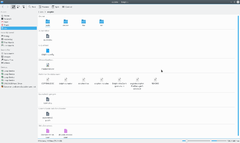
细节
"细节"视图模式下对比"图标"视图模式默认会显示许多额外的信息。所有文件都列在一个表格内。表头的关联菜单能够添加额外的列。可用的列如下:
- 大小
- 日期
- 权限
- 拥有者
- 群组
- 类型
分列 "名称" 总是显示的。点击每个分列的顶部,列表会根据这个分列重新排序。点击分列顶部,分类序列会复原(译者注:靠(#‵′) 为什么我这不会恢复,只会反向再排序一次)。
自从KDE 4.1后Dolphin能够树形展开显示文件夹。在这种模式下,一个加号的标记符号会在文件夹旁显示。点击标记符号,文件夹就会被展开,所有包含的子文件夹和文件也会显示在列表but they are itenuated.点击标记符号后标记符号会变成减号,再次点击,展开就会被关闭。当然多少的文件夹都能用树形结构。树形视图默认是没启用,可以通过 打开选项启用。
分列
视图模式"分列"的创意来自Mac OS X的文件管理器Finder。进入子文件夹并不会替换当前的文件夹视图,子文件夹的内容会在父文件夹的列旁边的额外的一列内显示。这适用于多个分层结构,所以你能以方便快速的方法在文件系统里浏览。
设置所有文件夹默认的视图属性
在菜单项,你能为所有的文件夹浏览设置默认的任何属性。
面板
Dolphin 包含了多个面板,能通过菜单激活。每个面板都能放到左侧或右侧dock区域。要移动面板你必须点击面板顶部然后拖放面板。释放鼠标将被放置面板的那个区域会被高亮。面板可以堆叠在其他面板之上。在这种情况下,面板会放入分页标签。
在每个面板的标题有两个按钮。接近标题的按钮可以游离(undock)面板。这使得面板成为一个独立的窗口「漂浮」于 Dolphin上。但窗口还是与 Dolphin结合的,不能在没有 Dolphin时显示,不能像普通窗口一样最小化。再次点击按钮,面板可以回复停靠。第二个按钮会关闭面板。
非模态窗口(Non Modal Dialogs)
当移动,复制或删除文件/目录,这个对话框甚至会在操作还没完成的时就消失不见。然后一个进度条便出现在屏幕右下角,之后也会消失,如果你想要查看进度你需要点击系统托盘里的一个小的「i」信息图标。
地址
Dolphin 包含了一种被叫做"地址"的书签。通过(键盘快捷键F9)激活显示在一个面板内。地址的内容跟K菜单 Kickoff菜单 中的"计算机"目录一样。
点击地址中一个,他就会在当前文件夹视图内打开。右键关联菜单能够编辑「地址」或再次删除它们。同样能临时隐藏个别的条目。
文件夹的关联菜单能用来添加这个文件夹作为一个条目到「地址」面板,有个菜单项是。你也能拖放一个文件夹到「地址」面板。
地址面板也包含了链接到可移动设备比如USB-keys或CD的条目。如果设备被挂载会显示一个小的「插头图标指示」。关联菜单能够卸载这个设备。
「地址」被使用作为「面包屑导航栏」中的基础,导航栏中显示的地址,起点就是「地址」中与其有关的最近的父文件夹。
信息
The information panel can be activated via (keyboard shortcut F11). This panel displays a preview or an icon of the currently selected file/folder or of the file/folder below the mouse cursor. Some additional information like change date or size to the file/folder is displayed as well.
The information panel offers the possibility to rate files, add a comment or tag a file. This is one of the interfaces to the semantic Desktop Nepomuk which provides the advantages of the semantic web for the desktop. Starting from KDE 4.2 it is possible to search for the semantic links given by the tags.
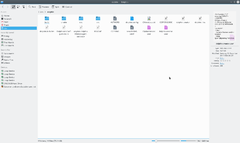

Folders
A panel providing a tree structure for the file system can be displayed via (keyboard shortcut F7). The tree structure offers the possibility by clicking the + and - signs to expand/collapse sub folders. By clicking on one of the folders the content will be displayed in the current view.
Terminal
The terminal emulator Konsole can be displayed directly in Dolphin via (keyboard shortcut F4). This makes it possible to use shell commands directly in Dolphin. The terminal is opened in the folder which is displayed in the current view. Shift + F4 opens Konsole in new window.
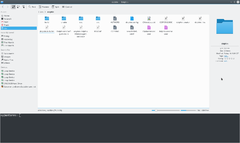
External links
Road to KDE 4: Dolphin and Konqueror
Ars Technica: A First Look at Dolphin
Youtube - KDE 4 rev 680445 - Dolphin
Introducing KDE 4 Blog - Dolphin
Bookmarks and Places
In KDE3 you could create bookmarks in Konqueror, but they were not available to any other application. KDE SC 4.x opens up a great deal more flexibility - but that inevitably means more complication. In fact KDE SC 4 has three classes of Bookmarks, which need to be differentiated. They reside in different files, and have different functions.
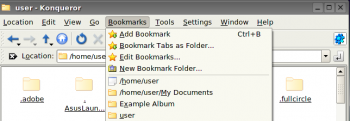
Three kinds of bookmark
First, there is the set of bookmarks available only to Konqueror - web bookmarks. These are stored in ~/.kde/share/apps/konqueror/bookmarks.xml. Then there is a set which Dolphin calls Places. This set is available to all applications as well as the Dolphin file manager. Every time you use you will see this set. The third set of bookmarks are Application Bookmarks. These share one file, regardless of the application that set them, and are available to all applications, unless you restrain them to a specific application. More of that later.
Enable bookmarks
In most distros Bookmarks are not enabled by default. In order to use bookmarks we first have to enable them. Open a in most KDE applications and you will see, at the right-hand edge of the icon panel, a spanner or wrench. From the drop-down list, choose .
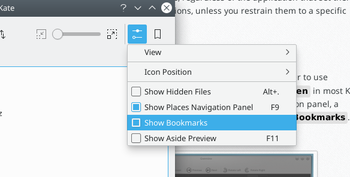
There is a default set of Places -
- Home
- Network
- Root
- Trash
but you can add other places. In Dolphin, right-click on a folder and select , or just drag a folder onto Places.
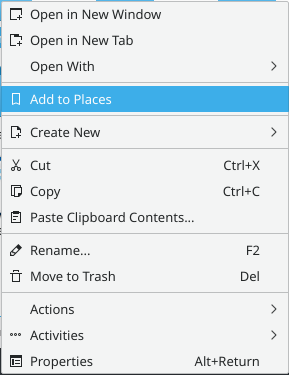
By default this "Place" will be visible in all applications. If you want to keep it constrained to Dolphin, you need to right-click on the new name in the Places list, where you will find the option to Edit it. There is a check-box for .
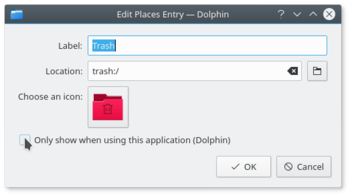
You can see the result of that command if you read ~/.kde4/share/apps/kfileplaces/bookmarks.xml.
In some applications too there is an option in the File menu to add a folder to Places. At this stage, however, applications vary in which features are available. The important thing to remember is that the default is for Places items to be available to all applications in the dialogue.
Bookmarks in applications
This is the second class of bookmarks. Remember opening and using the spanner/wrench? Next to it is a yellow star. This is the bookmark management menu.
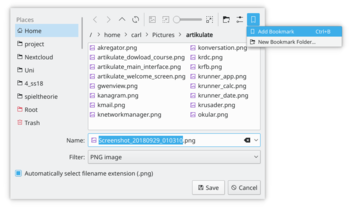
Here you can define bookmarks that will be visible in the same menu on any application. They are stored in one file, ~/.kde4/share/apps/kfile/bookmarks.xml, which is used by all applications having that menu.
Constraining to one application
Some applications allow you to edit items in the Places menu. For instance, if in Gwenview you right click on a folder in Places you can set an option to .
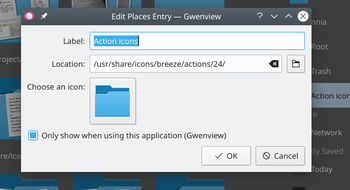
If you need to constrain to an application that does not yet allow you to do that, the only way left is to edit the file ~/.kde/share/apps/kfile/bookmarks.xml. Immediately before the </metadata> tag you will need to add the line
<OnlyInApp>appname</OnlyInApp>
Archive Management in Dolphin
Managing archives now becomes simple. In any directory in Dolphin, highlight the files that you want to compress, and right-click. Here, using the Compress option, you can elect to create a RAR archive, a Gzipped tar archive, or define another compression mode that you have already set up.
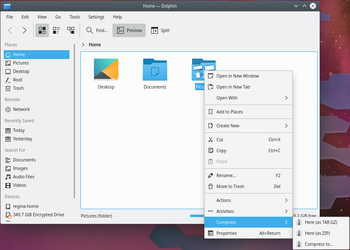
Similarly, if you right-click on an existing archived file you get a range of actions added to the right-click menu. You can extract the archive to the current folder, to an autodetected subfolder or to another place of your choosing.
Should you wish to add files to an existing archive, you can choose .
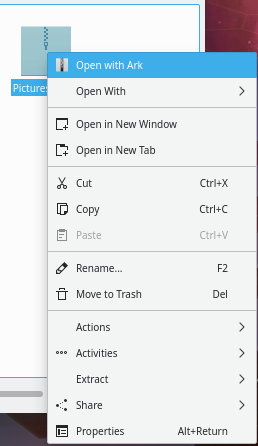
More Cool Actions
Change a File Association on-the-fly
Have you ever wanted to open a file, only to find that it is associated with an application that is not of your choice? You can, of course, alter this in . But Dolphin and Konqueror offer you a quick and cool method for changing a single association.
Right-click on the file and select . The first line there is descriptive, something like:
Type: XML document
At the same level, on the right, there is a spanner (wrench). Click on that and you can add or change an association.
Similarly, by working on a folder, you can change the default file manager to/from Konqueror, if you choose, or add another image browser to the possible associations.
The sub-menu opens up a whole lot more cool things to do from Dolphin. Some possibilities only appear when applicable to the file you have selected. Some of the options are
- Convert an image file to a different format
- Preview the file
- Download a remote file with KGet
- Sign and/or encrypt the file, according to the encryption software installed
Encode and copy audio CD tracks
- Insert an audio CD
- Navigate to this CD in Dolphin: it must appear as "Volume" in your Dolphin 'Places' or you can reach it by typing audiocd:/ in the address bar.
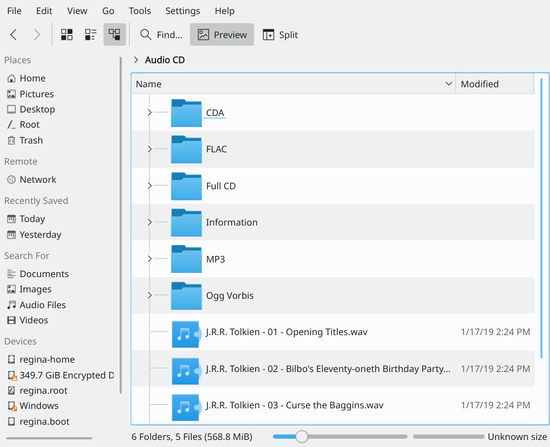
You now notice that Dolphin is proposing a WAV file for each track, plus:
- a CDA folder containing indexing information in the usual CDA format.
- a Whole CD folder, containing one file for each format (.cda, .flac, .mp3, .ogg, .wav) holding all the tracks
- a FLAC folder, containing the tracks encoded into FLAC format (lossless information format)
- an Information folder containing the CDDB informations
- an MP3 folder, containing all the tracks in MP3 format
- a Ogg Vorbis folder, containing the tracks encoded in OGG format
You then just have to copy the folder of your choice, in your preferred format to obtain the relative encoded version of your CD!
